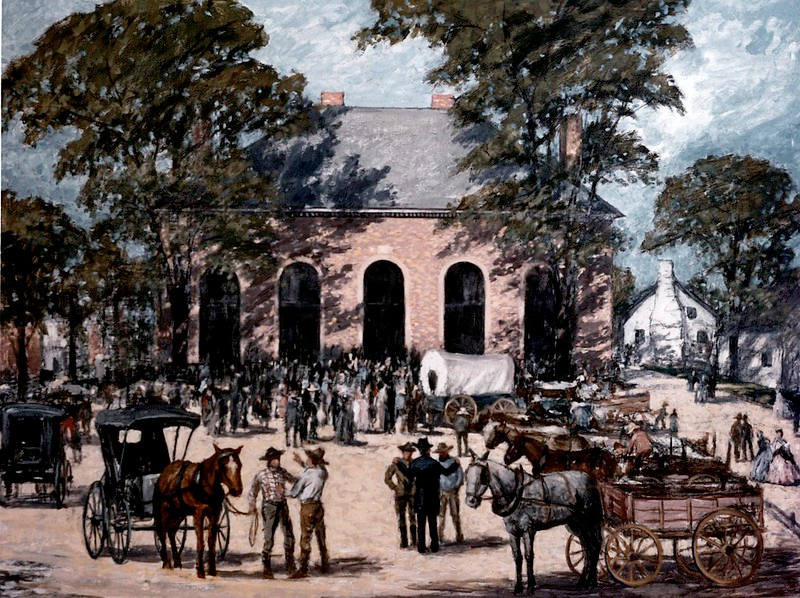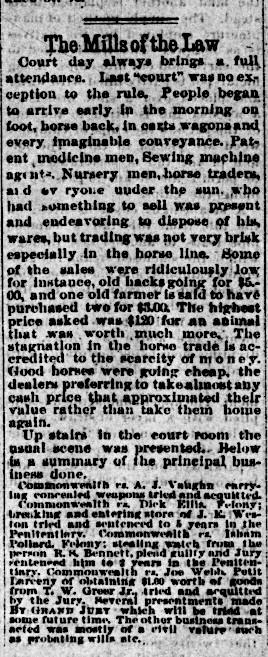
Fairfax County Courthouse, occupied by Union soldiers in June, 1863
Source: Alexander Gardner, Gardner's Photographic Sketch Book of the War

Fairfax County Courthouse, occupied by Union soldiers in June, 1863
Source: Alexander Gardner, Gardner's Photographic Sketch Book of the War
Political power is not concentrated exclusively in the state capital.
The English settled at Jamestown, and it was the initial center of government for the colony. John Smith sent some people to Kecoughtan in 1608, to spread out the colonists during a period of intense food shortage. The city now at that site, Hampton, claims to be the longest continuously-settled English speaking community in North America. [Henricus, the second town to be established by the colonists in 1610, was never re-settled after being destroyed in 1622 during a major attack by the Powhatans.]
After Lord de la Warre rescued the starving colonists in 1610, the population of Virginia remained concentrated along the James River. The London Company slightly decentralized the political authority in the colony with the initial creation of "hundreds," self-sufficient settlements that were required to be spaced several miles apart from each other.
The major decentralization of authority away from Jamestown started in 1618, when Governor Yeardley authorized local courts in Charles City and other "convenient places." In 1634, sixteen years later, the General Assembly created eight official "shires" (afterwards called "counties"). This established an official, but lower, level of colonial government outside of the capital.
County courthouses became key locations for executive, legislative, and judicial procedures. Colonial Virginians relied upon county courts for decisions that exceeded the authority of the landowners on individual plantations, but did not require the attention of the Governor, his Council, or the General Assembly. Colonial officials were all acting as proxies for the King, at least in theory. As power was decentralized throughout the colony, however, Virginia officials naturally responded more to the concerns of their neighbors than of a distant leader across the Atlantic.

the county courthouse has been the center of local government since counties were first created in 1634
Source: Federal Highway Administration, 1836 - The County Courthouse (painting by Carl Rakeman)
The only officials elected by the local residents before 1776 were the two Burgesses to the General Assembly. The justices on the court were appointed by the Governor. If there was a vacancy, the local justices recommended possible replacements - but until 1851, the Governor decided who would be appointed. Justices with the highest social ranking were considered to be members of the "quorum," and all sessions had to include at least one member with that status.
The clerk of the court and the sheriff were appointed by the county court. They received no salary, but instead set fees for their services. The sheriff, for example, earned a fee for collecting taxes- and he earned nothing if he failed to collect...
What happened at the county courthouse? Typically, once a month the community would assemble there for one day to hear the justices of the county court:

the Mecklenburg County courthouse in Boydton was a busy place on court day in 1893
Source: Library of Congress, The Midland express (March 3, 1893)
There was no separation of powers, no separation between executive, legislative, and judicial authorities, at the county court. Though the vestry and the county court were separate organizations, overlapping membership was common - the small percentage of the population that were Virginia gentry controlled all official forms of authority in colonial society. There was a geographic separation of powers, however. The General Court (which met every quarter) and the General Assembly (which met roughly once a year) assembled in the capital, while the county courts normally met each month at the county seats.
It was convenient to have the courthouse accessible to the general population. New counties were formed when it became too burdensome for a large percentage of the population to travel in one day by horseback to the courthouse, and courthouses were often moved to new locations as population centers changed.
Courthouses were often built on high points near the center of a county. The architecture and building materials were intended to demonstrate the stability and authority of local government. The "look and feel" of the places where judges, juries, and elected officials made decisions helped get the general population to respect those decisions.
In an agricultural society with few "central places," the county court days provided rare opportunities for farmers to assemble, buy or sell items, and break the monotony of rural living. Taverns supplied food, drink, and lodging... merchants opened stables and stores... and towns grew up around most of Virginia's courthouses.